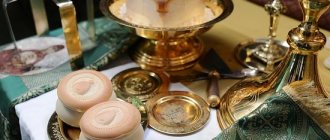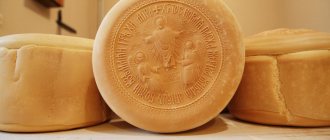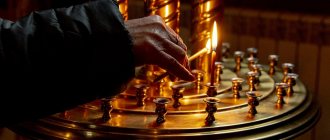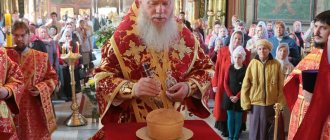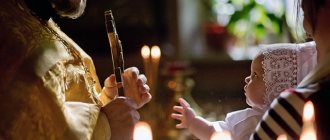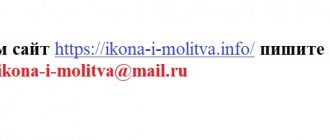Artos is considered a special bread that is associated with the greatest miracle - the Resurrection of Jesus Christ. This shrine is distributed to believers only once a year - during the Easter period. Therefore, it is not surprising that the Orthodox always want to receive this shrine.
The word artos is translated from Greek as “leavened bread” - consecrated bread common to all members of the Church, otherwise - whole prosphora. Artos, throughout Bright Week, occupies the most prominent place in the church, together with the icon of the Resurrection of the Lord, and, at the end of Easter celebrations, is distributed to believers.
Where did the tradition of eating artos come from?
The use of artos dates back to the very beginning of Christianity. On the fortieth day after the Resurrection, the Lord Jesus Christ ascended to heaven. The disciples and followers of Christ found consolation in prayerful memories of the Lord; they recalled His every word, every step and every action. When they came together for common prayer, they, remembering the Last Supper, partook of the Body and Blood of Christ. When preparing an ordinary meal, they left the first place at the table to the invisibly present Lord and placed bread in this place.
An ancient recipe for choux pastry
If you are interested in the issue related to how prosphora is baked, it should be noted that there are several ways to prepare them. Here's another one. In this recipe, to prepare prosphora, you need to make choux pastry. Take 215 g of wheat flour and pour 320 ml of boiling water. Then we rub everything with a whisk and then, constantly stirring, add another 670 ml of boiling water.
Then divide the dough into two equal parts and leave it to cool. Meanwhile, pour 50 ml of boiled water, cooled to room temperature, take 10 g of pressed yeast or a teaspoon of dry yeast, mix thoroughly, then put the resulting mass in a warm place.
When an hour has passed, add one of the dough halves to the “awakened” yeast and leave to rise in a warm place for another 1.5 hours. At the end of this time, in order to, so to speak, “rejuvenate” the dough, you need to add another 150 g of flour and pour in 170 ml of warm water. Then mix everything thoroughly and leave in a warm place for 2 hours. Next, prepare an aqueous salt solution from 40 g of salt and 170 ml of warm water. At the end of the preparation of the prosphora dough, you need to combine the resulting dough with the unused half and an aqueous salt solution.
What does artos symbolize?
Imitating the apostles, the first shepherds of the Church established that on the feast of the Resurrection of Christ, bread should be placed in the church as a visible expression of the fact that the Savior who suffered for us became for us the true bread of life. The artos depicts a cross on which only the crown of thorns is visible, but there is no Crucified One - as a sign of Christ’s victory over death, or an image of the Resurrection of Christ.
Artos is also connected with the ancient church tradition that the apostles left part of the bread at the table - the share of the Most Pure Mother of the Lord - as a reminder of constant communication with Her, and after the meal they reverently divided this part among themselves. In monasteries, this custom is called the Rite of Panagia, that is, the remembrance of the Most Holy Mother of the Lord. In parish churches, this bread of the Mother of God is remembered once a year in connection with the fragmentation of the artos.
Prosphora.
Its prototype was the showbread (unleavened) in the tabernacle of Moses. The showbread consisted of two parts, which symbolized the earthly and heavenly bread, that is, two principles, Divine and human. The commandment to offer bread as a sacrifice has come to us from Old Testament times: “he shall bring leavened bread as his offering, with a peace offering of thanksgiving” (Lev.7:13).
Prosphora is that leavened, that is, yeast, bread. The prosphora is made round as a sign of the eternity of Christ and humanity in Christ, in general as a sign that man was created for eternal life.
The history of the appearance of prosphora.
Thanksgiving and prayers over the gifts were an integral part of the sacred rite during which the Sacrament of Communion was performed. The very Body and Blood of Christ received the name - thanksgiving (in Greek - eucharist).
Later, the Third Council of Carthage in 391 decreed that the faithful prepare for the Eucharist by fasting, and therefore separated the Eucharist from agape. The Councils of Laodicea and Trullo (392) prohibited the performance of agape in the temple and thereby completely deprived them of their church-religious character. When agapa, the “supper of love,” was separated from the Liturgy, only the bread used to celebrate the Eucharist began to be called prosphora.
Preparation of prosphora.
The lower part of the prosphora corresponds to the earthly (carnal) composition of man and humanity; the upper part with the seal corresponds to the spiritual principle in man and humanity, in which the image of God is imprinted and the Spirit of God is mysteriously present. When making prosphora, holy water is added, which signifies the grace of God. Yeast signifies the life-giving power of the Holy Spirit, giving life to every creature. Flour and water in the prosphora symbolize human flesh, and yeast and holy water symbolize the soul.
Liturgical use of prosphora.
For the Divine service, in fact, one prosphora is needed - the one from which a portion is taken out for the Lamb, but according to the custom of ancient times, when five prosphoras were used, this amount is the smallest for performing proskomedia. There can be more than a dozen prosphora, and in large churches there can be hundreds. There can be as many prosphoras as the number of notes “On health” and “On repose”.
You should not eat completely stale or moldy prosphora. For the Lamb, it is more convenient to take a slightly hardened prosphora (baked the day before) than a freshly baked one, since it is easier to cut out the Holy Lamb from the former and, after consecration, it is more convenient to crush it into particles for the communion of the laity.
The prosphora can be received at the candle box after the liturgy by submitting a note “On health” or “On repose” before the start of the service. The names indicated in the notes are read at the altar, and for each name a particle is taken out of the prosphora, which is why such a prosphora is also called “taken out”.
Together with the prosphora, red grape wine is used to perform the Sacrament, specifically red, as an image of blood.
In the Eastern Church, the first mention of antidoron appears no earlier than the 11th century. The oldest can be considered the testimony of "Explanations on the Liturgy" of Herman of Constantinople according to the list of the 11th century. Next, you should indicate the testimony of Balsamon (XII century) in the 15th answer to the Alexandrian Patriarch Mark. According to the Nomocanon, if the particles of the prosphora from which the Holy Lamb is taken are insufficient for the antidor, prosphora in honor of the Most Holy Theotokos can be used to prepare it.
According to the instructions of the Helmsman, antidor is not taught to infidels and those under penance.
Artos - Whole Prosphora.
The artos depicts a cross on which only the crown of thorns is visible, but there is no Crucified One - as a sign of Christ’s victory over death and the Resurrection of Christ.
The artos is consecrated with a special prayer, sprinkling with holy water and censing on the first day of Holy Pascha at the Liturgy after the prayer behind the pulpit. The artos is placed on the prepared table, on the salt, opposite the royal doors. If several artos are prepared, then they are all consecrated at the same time. After censing around the table with the artos installed, the priest reads a special prayer. After reading the prayer, the priest sprinkles the artos with holy water three times, saying: “This artos is blessed and sanctified by sprinkling this sacred water, in the name of the Father and the Son and the Holy Spirit. Amen."
The lectern with the consecrated artos is installed on the sole in front of the image of the Savior, where the artos is located all the days of Bright Week. On all these days, at the end of the liturgy with artos, a procession of the cross around the temple is solemnly performed. On Saturday of Bright Week at the end of the liturgy, the priest says a prayer for the fragmentation of the artos. The artos is fragmented and at the end of the Liturgy, during the kissing of the Cross, it is distributed to the people as a shrine.
The prosphora and artos received in the church are reverently kept by believers in the holy corner near the icons, as spiritual healing for illnesses and infirmities. Artos is used in these special cases always with the words “Christ is risen!” ".
Spoiled prosphora and artos should be burned yourself (or taken to church for this) or floated down the river with clean water.
The genus of artos of the lower degree of consecration is represented by Easter cake - church ritual food.
Eucharistic Lamb.
The lack of ancient evidence about the Eucharistic Lamb and its preparation is due to the fact that the proskomedia on which it is prepared is a relatively recent phenomenon. For a long time, it consisted of a simple selection of the best bread and wine brought by the people. The selected bread was consecrated in its entire, untouched form, in which it was brought and broken into pieces only immediately before communion.
The first mention of the Eucharistic Lamb belongs to the Patriarch of Constantinople Germanus (died in 740). The sequence of sacred rites developed in the 10th – 15th centuries.
The use of other prosphoras during proskomedia.
From the third prosphora a particle is taken in memory of the Old Testament and New Testament saints, from the fourth a particle is taken for the living members of the Church, and from the fifth - for the deceased. Next, particles are taken out from the prosphoras served by believers for health and repose with the remembrance of names. The particles taken from the prosphora at the end of the Liturgy are immersed in the Holy Chalice, as the priest pronounces the words: “Wash away, Lord, the sins of those who were remembered here by Your honest Blood, by the prayers of Your saints.”
The spear used to cut out particles from prosphoras is an instrument of God’s Providence.
The spiritual meaning of the copy is similar to the Cross of Christ, which was previously an instrument of shameful execution, but in Christ became an instrument of salvation and the glory of God. The spear, being an instrument of death, becomes in Christ an instrument of salvation for the faithful for eternal life in the glory of the Kingdom of Heaven. This gives the consecrated church copy a grace-filled power that has a healing effect. The Trebnik contains a brief “Following the passion of the disease.” with a holy copy,” which the priest does over a sick person, making the sign of a cross over him with a copy.
Transubstantiation of the Holy Gifts.
Communion of the Holy Gifts.
Saint John Chrysostom gave orders to all churches to give communion to the laity using a spoon (spoon), with which particles of the Body of Christ, previously immersed in His Blood and soaked with It, are removed from the Chalice. At the same time, it became a custom to immediately wash down Communion with warm water and wine for clear evidence that every layman had actually received the Holy Mysteries.
At the behest of St. John Chrysostom, the entire order of communion was established. On the right in the altar, as in the upper room of Zion, the clergy, who in this case represent the disciples closest to Christ, the Apostles, partake of the Holy Mysteries separately, as they were taught by Christ at the Last Supper. Then, through the open Royal Doors, the Chalice, in which particles of the Body of Christ are already stained with His Blood, is solemnly brought out to the laity, which marks the Resurrection of the Lord Jesus Christ.
The laity partake of the Body and Blood united together. In addition, the communion of the laity through the spoon spiritually means that believers in Christ are united with God through the Church, which feeds them with spiritual food. Therefore, the lie means the mediation of the Church in the spiritual care of people in the broadest sense.
Insertion of particles taken from the prosphora into the Chalice.
The first bowls were made of wood; glass chalices appeared around the 3rd century. Since the 4th century, gold and silver chalices became widespread.
After the completion of the communion of the laity, the clergyman puts into the Chalice those particles that were removed about the Most Holy Theotokos, about the saints, about the living and the dead. The particles taken out “On Health and Repose” are put into the Chalice and thus come into contact with the Body and Blood of Christ the Savior. This is the power and effectiveness of removing particles from prosphoras. Sins are cleansed by a bloodless Sacrifice. Each particle, imbued with the Blood of the Savior, becomes an intercessor before the Savior for the one whose name it is taken from. That is why the Orthodox Church believes that taking out a particle from the prosphora about the living or dead at the Liturgy is the most saving and fruitful action.
How is artos consecrated?
The artos is consecrated with a special prayer, sprinkling with holy water and censing on the first day of Holy Pascha at the Liturgy after the prayer behind the pulpit. Artos rests on the sole, opposite the Royal Doors, on a prepared table or lectern. After the consecration of the artos, the lectern with the artos is placed on the sole in front of the image of the Savior, where the artos lies throughout Holy Week. It is kept in the church throughout Bright Week on a lectern in front of the iconostasis.
On all days of Bright Week, at the end of the Liturgy with artos, a procession of the cross around the temple is solemnly performed. On Saturday of Bright Week, after the prayer behind the pulpit, a prayer is read for the fragmentation of the artos, the artos is fragmented and at the end of the Liturgy, when kissing the Cross, it is distributed to the people as a shrine.
Is it allowed to clean on Holy Saturday?
During Bright Week, and therefore on Saturday, it is forbidden to drink alcoholic beverages, and you also cannot be overly thrifty and stingy. You can’t quarrel, make a scandal, or be discouraged - this is a bad omen. On Saturday you need to rest, so you can’t clean. Minor household chores are allowed - you can cook food, care for plants. You can’t go to the cemetery: for this there will be Radonitsa, which in 2022 will fall on May 7th.
Signs for Bright Week after Easter
During the entire Bright Week, you cannot do handicrafts - sewing, knitting, embroidering: they say that this is how the eyes of a dead person are “sewn up”, and he cannot find his way home. It is forbidden to wash, otherwise you can “muddy” the waters of the deceased.
In the week after Easter, there is no crying or lamentation at the graves of the dead, even those who have died recently. The clergy explain: if you show grief, the dead will not be able to rejoice at the Bright Resurrection.
From the day of Easter, young girls prepare for marriage. The one who wants the wedding to happen soon climbs the bell tower on Easter first and rings the bells. The day after Bright Saturday comes the Red Hill holiday. At this time, preparations are being made for the wedding, viewings are organized, and the girls’ get-togethers begin.
When the shrine is distributed
In the Orthodox tradition, artos is blessed on Easter - leavened bread of special consecration. Those who could not receive communion on Easter could feel unity through eating common bread. Now artos is distributed to believers to keep at home for a year; it is customary to eat it on an empty stomach in case of illness. In the church, every Orthodox believer can receive an artos on the 6th day of Bright Week.
The tradition of distributing artos bread dates back to the time of the apostles. After Jesus was resurrected on the 40th day, he ascended to Heaven, and his followers found comfort in the memories of Him and everything connected with Him. During the common prayer, the apostles remembered the Last Supper, and the first place at the table was empty. This is due to the fact that it was intended for the Teacher, and bread was placed in this place.
Artos bread is a symbol of the fact that Jesus Christ accepted all the sins that people have committed. Thanks to such bread, people receive proof that the Savior is always invisibly nearby. The artos depicts a cross and a crown of thorns, and this reminds people that Jesus managed to defeat death. The bread resembles prosphora, but it is only larger in size.
Artos bread, bread stamp
The Savior administered the first communion at the Last Supper. Communion was called the “Breaking of Bread” and signified the disciples’ participation in the Body of Christ.
“Bread of Life” has its own symbolism. The seal depicts a cross, a crown of thorns, the faces of saints, and lines from prayers.
Stamp forms are made from various materials. They can be plastic, metal, wood. Each of the materials has its own pros and cons.
- The most widely used are wooden ones. They are affordable and ergonomic. The disadvantage of this material is the lack of a clear pattern. If stored incorrectly, prints may swell and become deformed.
- Impressions made of plastic or plexiglass are the most practical. They need proper care as they are very fragile. It is impossible to make deep drawings on plastic. Therefore, the print on the test will not be clear. When purchasing such a print, give preference to the one where the pattern is more prominent.
- Metal prints are the most practical and high quality. The drawing on the test turns out clear. The dough does not stick to this print. When purchasing a print, give preference to one made of brass.
How to store a shrine
Like any shrine, artos requires a reverent attitude - if neglected, it, like ordinary bread, can become moldy. For long-term storage, it is usually divided into small pieces and, after drying, stored in a bag (preferably linen).
Believers believe that eating holy bread helps with various diseases and grants healing and good health. The old Russian custom has been preserved: when it was not possible to get to the Holy Week service, the shrine was consumed on an empty stomach with holy water. The shrine is used in special cases, for example in illness, and always with the words “Christ is risen!”
The artos is kept in a secluded place, most often near icons or any other things memorable to a Christian. Church bread is usually placed in small linen bags, but the bag can be replaced with a regular bag.
Pieces of Lamb
Many people who believe in God go to church and pray. These are sacred rituals, using the right meal, keeping a fast. Small pieces of Lamb are cut out from a piece of prosphora. They are served in any churches during or after services. The meaning of the prosphora is similar to the antidora. Antidora means "communion". So prosphora is used for remission of sins and cleansing of the soul. People cannot take communion every day, but every person can afford to eat a piece of prosphora. This is the symbol of communion.
It is necessary to take the prosphora with your hands crossed crosswise. Then kiss the hand of the priest who gave the prosphora.
